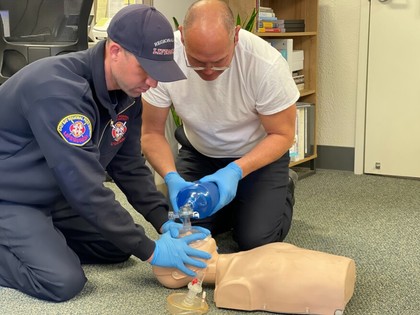A Critical Refresher on Ventilations

Wednesday, May 3, 2023
Effective ventilations should be a priority for in-service training of staff.
Providing ventilations is difficult and must be practiced frequently to maintain a high level of proficiency and readiness. Provide clear messaging about why staff must train on this skill: “Doctors, nurses, paramedics, fire and first responder personnel must train routinely on ventilations. Lifeguards are first responders and must train as much as other medical and emergency personnel, if not more. For a water emergency, lifeguards will be first on scene and must be able to provide ventilations to a victim who cannot breathe.”
When breaking down the in-service, include these areas of focus:
Skill refresher on opening the airway from the lateral and cephalic positions
Effective sealing of a resuscitation mask and mask from a BVM on a victim
Speed of initiating the care and transitioning to uninterrupted ventilations
Scenarios that involve a child or adult victim pulled from the water
AIRWAY MANEUVER DRILL (skill refresher): Pair up lifeguards, with one as rescuer, one victim. Manikin will be used. Primary rescuer is 10 feet away from the victim, who is in the supine position.
Objective: Move quickly into position and open the airway. Victim is non-spinal.
Go through each maneuver:
Lateral: Head-tilt/ Chin-lift
Cephalic: Jaw-thrust with head extension
Cephalic: Jaw-thrust without head extension
Timing goal: 3-7 seconds per maneuver.
MASK SEALING DRILL: Pair up lifeguards. Manikins will be used. Resuscitation and BVMs should be available. Lifeguards should be 10 feet away from the manikin in a supine position.
Objective: Move to the victim, effectively seal the mask, and provide ventilations.
Go through each maneuver:
Sealing a resuscitation mask on a child, provide ventilations, one every 3 seconds
Sealing a resuscitation mask on an adult, provide ventilations, one every 5 seconds
Sealing a BVM mask on a child, provide ventilations, one every 3 seconds
Sealing a BVM mask on an adult, provide ventilations, one every 5 seconds
Lifeguards should provide at least three to five ventilations to verify that they have an effective seal on the victim.
Timing goal: 15 to 30 seconds per maneuver.
UNINTERRUPTED VENTILATIONS DRILL: Pair up lifeguards. Manikins will be used. Have resuscitation and BVMs available. Lifeguards should be 10 feet from manikin, supine position.
Objective: Move to the victim, perform a primary assessment, and determine the victim has a pulse but is not breathing. Effectively seal the mask and provide ventilations for 2 minutes.
Go through each maneuver:
Provide ventilations on a child with a resuscitation mask for 2 minutes
Provide ventilations on a child with a BVM mask for 2 minutes
Provide ventilations on an adult with a resuscitation mask for 2 minutes
Provide ventilations on an adult with a BVM mask for 2 minutes
VENTILATION SCENARIOS: Pair up lifeguards. Manikins are used for the dryland portion, a real person for the water portion. A backboard is used for the extrication. Have resuscitation and BVMs available. Lifeguards are staging or in the lifeguard tower depending on the scenario.
Objective: Move to/or rescue the victim, extricate the victim, when necessary, perform a primary assessment, and determine the victim has a pulse but is not breathing. Effectively seal the mask and provide ventilations for 2 minutes.
Go through each maneuver:
An adult is located on land, not breathing, no spinal injury suspected. Provide ventilations for 1 minute with a resuscitation mask. Then transition to ventilations with a BVM for 1 more minute
A child is pulled from shallow water, not breathing, no spinal injury suspected. Perform a rapid extrication, followed with ventilations for 1 minute with a resuscitation mask. Then transition to ventilations with a BVM for 1 more minute
A child is pulled from deep water, not breathing, no spinal injury suspected. Perform a rapid extrication, followed by ventilations for 2 minute with a BVM. Switch out both lifeguards with two fresh lifeguards, then continue to provide ventilations with a BVM for 1 more minute
Child is pulled from deep water, not breathing, no spinal injury suspected. Perform rapid extrication, followed by ventilations from a resuscitation mask. The mask becomes compromised, so lifeguards switch to a new mask and continue ventilations. Provide ventilations for 1 minute, second pair of lifeguards arrive with BVM. Switch lifeguards and transition to ventilations with BVM. BVM mask becomes compromised and needs to be switched. Replace compromised BVM mask with resuscitation mask. Attach resuscitation mask to BVM. Continue ventilations for 1 minute
Time breakdown for the 30-minute in-service:
MISTAKES TO LOOK FOR
Look for errors that could delay or compromise care. Here are some you might see:
The lifeguard’s position doesn’t support how the airway is opened or how the mask is sealed
When sealing the mask, the lifeguard is smashing the mask onto the victim’s face, which has the high potential of closing the victim’s airway
Between ventilations or during the transition to a new lifeguard taking over airway management, the victim’s airway is allowed to close
The lifeguards either under-inflate or over-inflate the victim’s chest. Remember, just enough to allow the chest to rise
To make the 30-minute in-service compact and effective, use the best setting. Have enough equipment and manikins with working lungs, as well as extra lungs. Make sure you are proficient at doing a quick lung change-out.